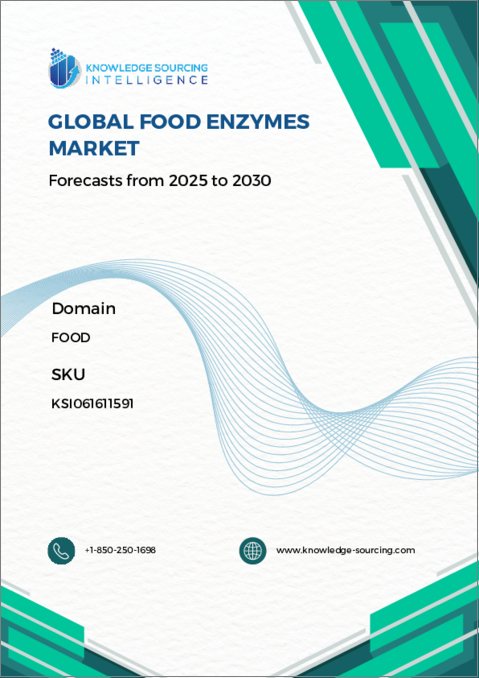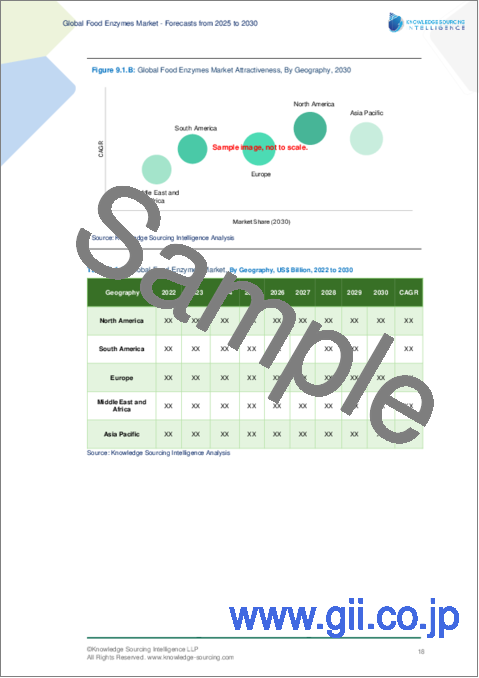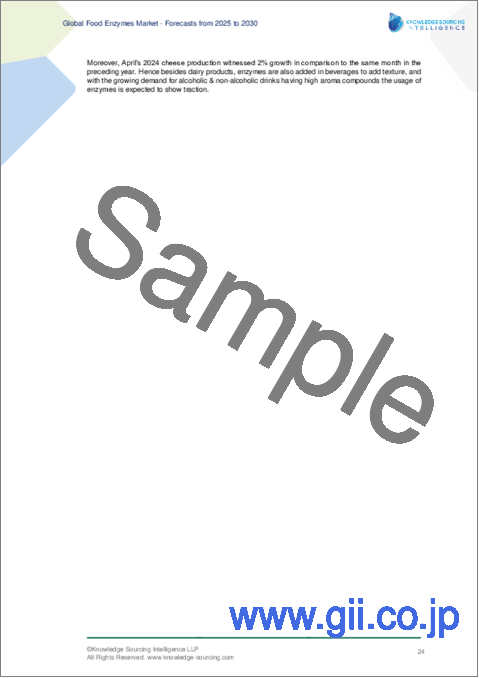|
|
市場調査レポート
商品コード
1479925
食品酵素の世界市場-2024年から2029年までの予測Global Food Enzymes Market - Forecasts from 2024 to 2029 |
||||||
カスタマイズ可能
|
|||||||
| 食品酵素の世界市場-2024年から2029年までの予測 |
|
出版日: 2024年03月04日
発行: Knowledge Sourcing Intelligence
ページ情報: 英文 132 Pages
納期: 即日から翌営業日
|
全表示
- 概要
- 目次
食品酵素市場はCAGR 7.76%で成長し、2022年の40億7,800万米ドルから2029年には68億8,200万米ドルに達すると予測されています。
食品酵素は人間の消費に適した酵素であり、食品の安全性と品質、プロセス効率の向上を支援するために、食品製造を通じて食品産業で利用されています。広範な食品の製造、加工、調製、処理に広く使用されています。製パン、フルーツジュース、チーズ製造、醸造などは、酵素を使用する産業のひとつです。
加工食品の需要の増加は、食品酵素産業を後押しすると思われます。さらに、酵素工学や遺伝子組み換え酵素の導入といった技術開発も、食品産業の拡大を後押ししています。
食品酵素は、タンパク質からでんぷんに至るまで、食品加工のあらゆる面で極めて重要です。さらに、乳製品やアルコール発酵の原料処理を強化するためにも利用されています。製パンもまた、酵素が不可欠な役割を果たす注目すべき分野です。
このように、様々な用途における食品酵素の多機能な利点や、化学物質の使用量を最小限に抑える技術の進歩といった要因はすべて、市場の成長に寄与しています。しかし、温度とpHの操作範囲が限られているため、市場の拡大が制限される可能性があります。
市場促進要因:
- 加工食品の需要
加工食品需要の増加加工食品に対する世界の需要は、主にアジア経済の拡大により増加しています。加工食品セクターの大幅な拡大の主因となっているのは中国とインドです。
インド・ブランド・エクイティ財団によると、インドの食品・食料品市場は世界第6位であり、その生産高は2025~26年までに5,350億米ドルに達すると予想されています。インドの食品加工部門は食品市場全体の32%を占め、主要産業であり、生産量、消費量、輸出量、予想成長率で第5位にランクされています。
市場の抑制要因
- 温度とpH操作範囲の制約
食品酵素の活性は環境要因に大きく影響されます。温度の低下は反応速度を劇的に低下させ、一方、熱撹拌は食品酵素の構造を劣化させ、機能しなくします。食品酵素の作動範囲外でpHを変化させると酵素活性が低下し、最終的には不可逆的な変性につながります。
食品酵素市場の供給源別細分化:微生物、植物、動物
食品酵素市場の供給源別セグメンテーションには、微生物、植物、動物が含まれます。細菌や真菌などの微生物は、培養コストが比較的低いため、酵素生産において費用対効果の高い選択肢となります。
植物は微生物に比べて酵素の種類が少ないため、酵素抽出のソースとしてはあまり一般的ではありません。動物は、微生物や植物に比べれば程度は低いもの、食品用途の酵素利用可能性に貢献しています。
北米が食品酵素市場で大きなシェアを占めると予想されます。
北米が食品酵素市場で圧倒的なシェアを占めています。しかし、予測期間中、アジア太平洋は世界の食品酵素市場でかなりの市場シェアを獲得すると予想されます。食品用途の固定化酵素技術は、近年大きな人気を博しています。固定化酵素技術は、遅い反応速度、短い貯蔵寿命、操作安定性などの食品酵素特性を改善します。
市場開拓:
- 2023年 9月-ノボザイムズは、食感を改善することで植物由来の食肉体験を再定義し、より多くの消費者に植物由来の代替食品を選択してもらうことを目的とした画期的なバイオソリューションを発売しました。Vertera(R)ProBiteは植物性食肉分野への革新的なソリューションとして発表され、食感を向上させ、消費者にわかりやすいラベルを付けた、現在および将来の植物性食肉製品の開発に新たな道を開く。
- 2023年5月-DSM-Firmenich社は、無乳糖乳製品の生産効率を高める市場最速の純粋ラクターゼ酵素として注目されるMaxilact(R)Nextを発表。今回発表されたソリューションは、当時市場で入手可能な最も効率的で純粋なラクターゼです。Maxilact(R)Nextは、生乳処理に利用されていた従来の市場最速のリファレンスを凌駕し、同レベルを投与した場合、加水分解時間が25%短縮されました。
目次
第1章 イントロダクション
- 市場概要
- 市場の定義
- 調査範囲
- 市場セグメンテーション
- 通貨
- 前提条件
- 基準年と予測年のタイムライン
- ステークホルダーにとっての主なメリット
第2章 調査手法
- 調査デザイン
- 調査プロセス
第3章 エグゼクティブサマリー
- 主な調査結果
- アナリストビュー
第4章 市場力学
- 市場促進要因
- 市場抑制要因
- ポーターのファイブフォース分析
- 業界バリューチェーン分析
- アナリストビュー
第5章 食品酵素の世界市場:タイプ別分析
- イントロダクション
- アミラーゼ
- 市場機会と動向
- 成長の見通し
- 地理的な利益性
- プロテアーゼ
- 市場機会と動向
- 成長の見通し
- 地理的な利益性
- リパーゼ
- 市場機会と動向
- 成長の見通し
- 地理的な利益性
第6章 食品酵素の世界市場:ソース別分析
- イントロダクション
- 微生物
- 市場機会と動向
- 成長の見通し
- 地理的な利益性
- 植物
- 市場機会と動向
- 成長の見通し
- 地理的な利益性
- 動物
- 市場機会と動向
- 成長の見通し
- 地理的な利益性
第7章 食品酵素の世界市場:アプリケーション別の分析
- イントロダクション
- 飲料
- 市場機会と動向
- 成長の見通し
- 地理的な利益性
- 加工食品
- 市場機会と動向
- 成長の見通し
- 地理的な利益性
- 乳製品
- 市場機会と動向
- 成長の見通し
- 地理的な利益性
- その他
- 市場機会と動向
- 成長の見通し
- 地理的な利益性
第8章 食品酵素の世界市場:地域別分析
- イントロダクション
- 北米
- タイプ別
- ソース別
- 用途別
- 国別
- 南米
- タイプ別
- ソース別
- 用途別
- 国別
- 欧州
- タイプ別
- ソース別
- 用途別
- 国別
- 中東・アフリカ
- タイプ別
- ソース別
- 用途別
- 国別
- アジア太平洋
- タイプ別
- ソース別
- 用途別
- 国別
第9章 競合環境と分析
- 主要企業と戦略分析
- 市場シェア分析
- 合併、買収、合意およびコラボレーション
- 競合ダッシュボード
第10章 企業プロファイル
- Amway
- AB Enzymes
- Advanced Enzyme Technologies
- DSM
- Novozymes
- Megazyme
- Biocatalysts
- Dupont
- Amano Enzyme Inc.
- Kerry Inc.
The global food enzymes market is projected to grow at a CAGR of 7.76% to reach US$6.882 billion by 2029, from US$4.078 billion in 2022.
Food enzymes are enzymes that are suitable for human consumption and are utilized by the food industry throughout food manufacturing to assist in enhancing food safety and quality, as well as process efficiency. They are widely used in the manufacture, processing, preparation, and treatment of a wide range of food products. Baking, fruit juice, cheese production, and brewing are among the industries that use enzymes.
The rise in demand for processed foods is likely to boost the food enzyme industry. Furthermore, technological developments such as enzyme engineering and the introduction of genetically modified enzymes have helped the expansion of the food industry.
Food enzymes are crucial in all aspects of food processing, from protein to starch. Furthermore, they are utilized to enhance raw material processing for dairy and alcohol fermentation. Baking is another notable sector in which enzymes play an essential role.
Thus, factors such as the multifunctional advantages of food enzymes in a variety of applications and technological advances to minimize chemical usage all contribute to the market's growth. However, a limited temperature and pH operational range may limit market expansion.
Market Drivers:
- Demand for processed foods-
A rise in the demand for processed foods Global demand for processed foods is increasing, owing primarily to expanding economies in Asia. China and India are primarily responsible for the significant expansion of the processed food sector.
The Indian food and grocery market is the world's sixth-largest, according to the Indian Brand Equity Foundation, and its production is anticipated to reach US$535 billion by 2025-26. The Indian food processing sector accounts for 32% of the total food market, is a major industry, and ranks fifth in terms of output, consumption, exports, and anticipated growth.
Market Restraint:
- Temperature and pH operational range restrictions-
The activity of food enzymes is heavily affected by environmental factors. A reduction in temperature dramatically reduces the reaction rate, whereas thermal agitation degrades the food enzyme structure, rendering it non-functional. Varying the pH outside of the food enzyme's operating range decreases enzyme activity and can eventually lead to irreversible denaturation
Global food enzymes market segmentation by source into microorganisms, plants, and animals.
The segmentation of the global food enzymes market by source includes microorganisms, plants, and animals. Microorganisms, such as bacteria and fungi, present a cost-effective option for enzyme production due to their relatively low cultivation expenses.
Plants offer a narrower range of enzyme types compared to microorganisms, making them less common sources for enzyme extraction. Animals contribute to enzyme availability for food applications, although to a lesser extent compared to microorganisms and plants.
North America is anticipated to hold a significant share of the food enzyme market-
North America holds the dominant share of the food enzyme market. During the projected period, however, Asia-Pacific is expected to earn a considerable market share in the global food enzyme market. The immobilized enzyme technology for food applications has gained significant popularity in recent years. Immobilized enzyme technology improves food enzyme properties such as slow reaction rate, short shelf life, and operational stability.
Market Developments:
- September 2023- Novozymes launched a groundbreaking biosolution aimed at redefining the plant-based meat experience by improving texture and enticing more consumers to opt for plant-based alternatives. Vertera(R) ProBite was introduced as an innovative solution to the plant-based meat sector, introducing fresh avenues for developing both current and future plant-based meat products with enhanced texture and consumer-friendly labeling.
- May 2023- DSM-Firmenich introduced Maxilact(R)Next, touted as the market's fastest pure lactase enzyme for enhancing lactose-free dairy production efficiency. The newly unveiled solution represented the most efficient and pure lactase available on the market at the time. Maxilact(R)Next outpaced the previous fastest market reference utilized in milk processing, boasting a 25% reduction in hydrolysis time when dosed at equivalent levels.
Market Segmentation:
By Type
- Amylase
- Protease
- Lipase
By Source
- Microorganisms
- Plants
- Animals
By Application
- Beverages
- Processed Food
- Dairy Products
- Others
By Geography
- North America
- USA
- Canada
- Mexico
- South America
- Brazil
- Argentina
- Others
- Europe
- Germany
- France
- UK
- Italy
- Others
- Middle East and Africa
- Saudi Arabia
- UAE
- Others
- Asia Pacific
- China
- Japan
- India
- Indonesia
- Taiwan
- Thailand
- Others
TABLE OF CONTENTS
1. INTRODUCTION
- 1.1. Market Overview
- 1.2. Market Definition
- 1.3. Scope of the Study
- 1.4. Market Segmentation
- 1.5. Currency
- 1.6. Assumptions
- 1.7. Base, and Forecast Years Timeline
- 1.8. Key benefits to the stakeholder
2. RESEARCH METHODOLOGY
- 2.1. Research Design
- 2.2. Research Process
3. EXECUTIVE SUMMARY
- 3.1. Key Findings
- 3.2. Analyst View
4. MARKET DYNAMICS
- 4.1. Market Drivers
- 4.2. Market Restraints
- 4.3. Porter's Five Forces Analysis
- 4.3.1. Bargaining Power of Suppliers
- 4.3.2. Bargaining Power of Buyers
- 4.3.3. Threat of New Entrants
- 4.3.4. Threat of Substitutes
- 4.3.5. Competitive Rivalry in the Industry
- 4.4. Industry Value Chain Analysis
- 4.5. Analyst View
5. GLOBAL FOOD ENZYMES MARKET ANALYSIS BY TYPE
- 5.1. Introduction
- 5.2. Amylase
- 5.2.1. Market opportunities and trends
- 5.2.2. Growth prospects
- 5.2.3. Geographic lucrativeness
- 5.3. Protease
- 5.3.1. Market opportunities and trends
- 5.3.2. Growth prospects
- 5.3.3. Geographic lucrativeness
- 5.4. Lipase
- 5.4.1. Market opportunities and trends
- 5.4.2. Growth prospects
- 5.4.3. Geographic lucrativeness
6. GLOBAL FOOD ENZYMES MARKET ANALYSIS BY SOURCE
- 6.1. Introduction
- 6.2. Microorganisms
- 6.2.1. Market opportunities and trends
- 6.2.2. Growth prospects
- 6.2.3. Geographic lucrativeness
- 6.3. Plants
- 6.3.1. Market opportunities and trends
- 6.3.2. Growth prospects
- 6.3.3. Geographic lucrativeness
- 6.4. Animals
- 6.4.1. Market opportunities and trends
- 6.4.2. Growth prospects
- 6.4.3. Geographic lucrativeness
7. GLOBAL FOOD ENZYMES MARKET ANALYSIS BY APPLICATION
- 7.1. Introduction
- 7.2. Beverages
- 7.2.1. Market opportunities and trends
- 7.2.2. Growth prospects
- 7.2.3. Geographic lucrativeness
- 7.3. Processed Food
- 7.3.1. Market opportunities and trends
- 7.3.2. Growth prospects
- 7.3.3. Geographic lucrativeness
- 7.4. Dairy Products
- 7.4.1. Market opportunities and trends
- 7.4.2. Growth prospects
- 7.4.3. Geographic lucrativeness
- 7.5. Others
- 7.5.1. Market opportunities and trends
- 7.5.2. Growth prospects
- 7.5.3. Geographic lucrativeness
8. GLOBAL FOOD ENZYMES MARKET ANALYSIS BY GEOGRAPHY
- 8.1. Introduction
- 8.2. North America
- 8.2.1. By Type
- 8.2.2. By Source
- 8.2.3. By Application
- 8.2.4. By Country
- 8.2.4.1. United States
- 8.2.4.1.1. Market Trends and Opportunities
- 8.2.4.1.2. Growth Prospects
- 8.2.4.2. Canada
- 8.2.4.2.1. Market Trends and Opportunities
- 8.2.4.2.2. Growth Prospects
- 8.2.4.3. Mexico
- 8.2.4.3.1. Market Trends and Opportunities
- 8.2.4.3.2. Growth Prospects
- 8.2.4.1. United States
- 8.3. South America
- 8.3.1. By Type
- 8.3.2. By Source
- 8.3.3. By Application
- 8.3.4. By Country
- 8.3.4.1. Brazil
- 8.3.4.1.1. Market Trends and Opportunities
- 8.3.4.1.2. Growth Prospects
- 8.3.4.2. Argentina
- 8.3.4.2.1. Market Trends and Opportunities
- 8.3.4.2.2. Growth Prospects
- 8.3.4.3. Others
- 8.3.4.3.1. Market Trends and Opportunities
- 8.3.4.3.2. Growth Prospects
- 8.3.4.1. Brazil
- 8.4. Europe
- 8.4.1. By Type
- 8.4.2. By Source
- 8.4.3. By Application
- 8.4.4. By Country
- 8.4.4.1. Germany
- 8.4.4.1.1. Market Trends and Opportunities
- 8.4.4.1.2. Growth Prospects
- 8.4.4.2. France
- 8.4.4.2.1. Market Trends and Opportunities
- 8.4.4.2.2. Growth Prospects
- 8.4.4.3. UK
- 8.4.4.3.1. Market Trends and Opportunities
- 8.4.4.3.2. Growth Prospects
- 8.4.4.4. Italy
- 8.4.4.4.1. Market Trends and Opportunities
- 8.4.4.4.2. Growth Prospects
- 8.4.4.5. Others
- 8.4.4.5.1. Market Trends and Opportunities
- 8.4.4.5.2. Growth Prospects
- 8.4.4.1. Germany
- 8.5. Middle East and Africa
- 8.5.1. By Type
- 8.5.2. By Source
- 8.5.3. By Application
- 8.5.4. By Country
- 8.5.4.1. Saudi Arabia
- 8.5.4.1.1. Market Trends and Opportunities
- 8.5.4.1.2. Growth Prospects
- 8.5.4.2. UAE
- 8.5.4.2.1. Market Trends and Opportunities
- 8.5.4.2.2. Growth Prospects
- 8.5.4.3. Others
- 8.5.4.3.1. Market Trends and Opportunities
- 8.5.4.3.2. Growth Prospects
- 8.5.4.1. Saudi Arabia
- 8.6. Asia Pacific
- 8.6.1. By Type
- 8.6.2. By Source
- 8.6.3. By Application
- 8.6.4. By Country
- 8.6.4.1. China
- 8.6.4.1.1. Market Trends and Opportunities
- 8.6.4.1.2. Growth Prospects
- 8.6.4.2. Japan
- 8.6.4.2.1. Market Trends and Opportunities
- 8.6.4.2.2. Growth Prospects
- 8.6.4.3. India
- 8.6.4.3.1. Market Trends and Opportunities
- 8.6.4.3.2. Growth Prospects
- 8.6.4.4. Indonesia
- 8.6.4.4.1. Market Trends and Opportunities
- 8.6.4.4.2. Growth Prospects
- 8.6.4.5. Taiwan
- 8.6.4.5.1. Market Trends and Opportunities
- 8.6.4.5.2. Growth Prospects
- 8.6.4.6. Thailand
- 8.6.4.6.1. Market Trends and Opportunities
- 8.6.4.6.2. Growth Prospects
- 8.6.4.7. Others
- 8.6.4.7.1. Market Trends and Opportunities
- 8.6.4.7.2. Growth Prospects
- 8.6.4.1. China
9. COMPETITIVE ENVIRONMENT AND ANALYSIS
- 9.1. Major Players and Strategy Analysis
- 9.2. Market Share Analysis
- 9.3. Mergers, Acquisition, Agreements, and Collaborations
- 9.4. Competitive Dashboard
10. COMPANY PROFILES
- 10.1. Amway
- 10.2. AB Enzymes
- 10.3. Advanced Enzyme Technologies
- 10.4. DSM
- 10.5. Novozymes
- 10.6. Megazyme
- 10.7. Biocatalysts
- 10.8. Dupont
- 10.9. Amano Enzyme Inc.
- 10.10. Kerry Inc.






